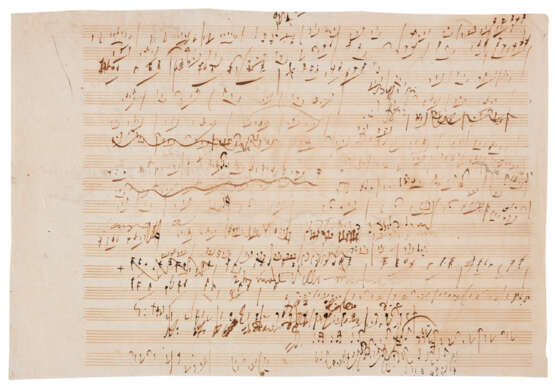ID 1349767
Lot 29 | Ludwig van Beethoven (1770-1827)
Valeur estimée
£ 100 000 – 150 000
Autograph sketch leaf for the string quartet in C, op. 59 no.3, the second movement, [Vienna, 1806]
Two pages, 203 x 297mm. Densely written on sixteen staves per page, with many cancellations and emendations including marginal additions on hand-drawn extensions to the printed staves, a few annotations by Beethoven, e.g. ‘2te mal Vcello morendo’, ‘Vide … d.c.’. Watermark: the top part of a fleur-de-lis watermark is visible, corresponding with Tyson (1982), paper 4, quadrant 2.
A densely-filled sketch leaf for one of Beethoven’s celebrated ‘middle period’ quartets. The ‘Razumovsky’ quartets are among the high points of Beethoven’s creativity, dating from the same years as the ‘Eroica’ Symphony, the ‘Appassionata’ Sonata and the Fourth Piano Concerto.
One of Beethoven's most radiant works, the string quartet op.59 no.3 was, like the other two 'Razumovsky' quartets, written for the Russian diplomat Andrey Kirillovich, Count Razumovsky (1752-1836): the set was first performed early in 1807 at Razumovsky's palace in Vienna by the quartet led by Beethoven's friend Ignaz Schuppanzigh, who two years previously had put on the first ever public concert series of chamber music. Public reaction to the quartets focused initially on their unprecedented complexity, and only this, the third quartet, was accorded a favourable reception, with the Allgemeine Musikalische Zeitung observing that 'it must please any educated music lover by its originality, melody and harmonic power' (27 February 1807). The third quartet is the only one of the group not to incorporate Russian folk themes in honour of the dedicatee, though commentators have identified an exotic flavour to this second, slow movement, particularly in its use of pedal points and pizzicato accompaniments, which may be intended to evoke a Russian atmosphere: certainly, in its sonata form with reversed capitulation and its meditative, almost obsessive mood, in striking contrast with the exuberance of the preceding Allegro vivace, it is, in Joseph Kerman's words (The Beethoven Quartets, 1967, p.145), 'quite unlike anything else that Beethoven ever wrote'; it has been characterised by A.B. Marx as 'seltsam fremd' (quoted in Kerman, op. cit., p.149) and by Philip Radcliffe as 'exceptionally original' (Beethoven's String Quartets, 1965, p.76).
Beethoven seems to have worked from single sketch leaves for the Razumovsky quartets, rather than his characteristic sketch books, and 25 loose leaves are noted at the Gesellschaft der Musikfreunde in Vienna. Aside from the present sketch leaf, only two others are known for the slow movement of op. 59 no. 3, one at the Royal College of Music in London, the other most recently seen at auction at Christie’s, 21 November 2012, lot 35. Although mentioned by Alan Tyson in 1982, the present leaf has not been extensively studied: its relation to the final form of the second movement is evident in the 6/8 rhythm and the general tonality, but in the absence of instrumental indications, and usually of clefs, the sketches cannot readily be mapped onto the music in its final form. They nevertheless provide direct insight into Beethoven's compositional thought-processes, and above all into the composer's deep and thorough examination of the possibilities of his musical material, even at the expense of leaving the results unused in the final composition.
Provenance
Johann Baptist Cramer (1771-1858, according to the Werkverzeichnis; Cramer is known to have acquired similar leaves at the posthumous auction in 1827, and was given another sketchleaf for this movement by the publisher Auguste Artaria in 1837); Antiquariat Hans Schneider, Tutzing (catalogue 206, May 1977) – Sotheby's, 22 November 1989, lot 12 (unsold) – sold by Schneider in October 1990 to – the present owners.
Literature
Werkverzeichnis (2014) I.1.9.
| Artiste: | Ludwig van Beethoven (1770 - 1826) |
|---|---|
| Lieu d'origine: | Autriche, Europe de l'Ouest, Europe |
| Catégorie maison de vente aux enchères: | Lettres, documents et manuscrits, Livres et manuscrits |
| Artiste: | Ludwig van Beethoven (1770 - 1826) |
|---|---|
| Lieu d'origine: | Autriche, Europe de l'Ouest, Europe |
| Catégorie maison de vente aux enchères: | Lettres, documents et manuscrits, Livres et manuscrits |
| Adresse de l'enchère |
CHRISTIE'S 8 King Street, St. James's SW1Y 6QT London Royaume-Uni | |
|---|---|---|
| Aperçu |
| |
| Téléphone | +44 (0)20 7839 9060 | |
| Commission | see on Website | |
| Conditions d'utilisation | Conditions d'utilisation |








![[Ludwig van Beethoven (1770-1827)] – Emma von Staudach (1834-1862)](/assets/image/picture_3451097/cdc3c/hxzdwwffezd8hu3e30wfxv2hrxwcuoagebfd1xyzvqti8zdscxlb6lihytxj61697037548jpg__fix_162_205.jpeg)


